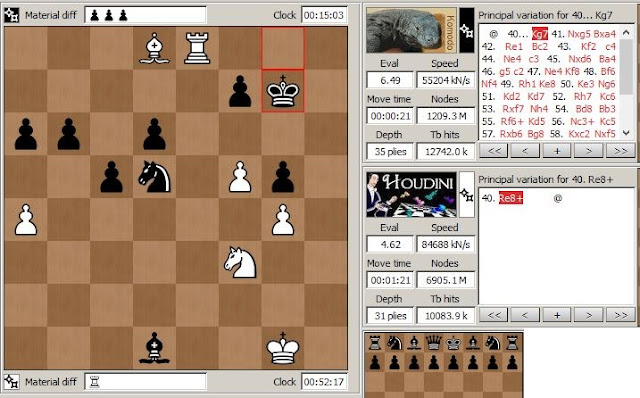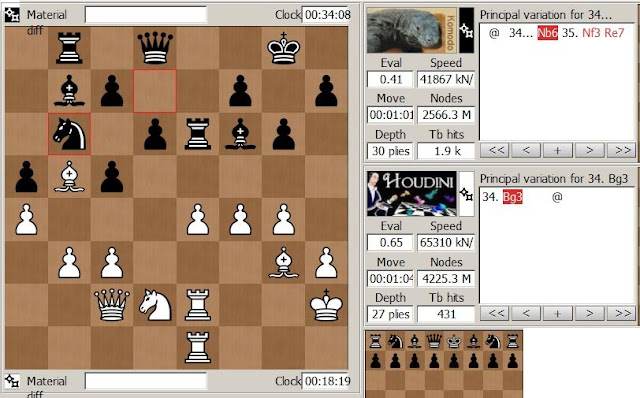After 60 games Houdini is in the lead, 9-4 and 47 draws. There were 4 decisive games in the last 10. The first two by Komodo, giving the appearance that it was closing the gap. The next two by Houdini, and with 40 games left it will probably win the match.
Evals were low in game 51, most of the queen side pawns were exchanged and then the four knights filled it, two self-protecting pairs that could not be moved. Komodo appeared to attack the black king through the long diagonal, yet its eval remained 0. A series of 7 moves that included 11 captures cleaned the board leaving a drawn knight ending.
In
game 52 Houdini advanced its king side pawns, closing the king side with very little room to move for black. Komodo won a pawn on the queen side while Houdini concentrated forces on the h file, it looked as if one wrong move by Komodo and its king would fall.

The engines shuffled for a while, Komodo defended the possible entry points and Houdini didn't find a safe way to break the defense. Evals came down gradually and even became slightly negative. Houdini was getting low on time. Komodo opened the queen side and exchanged pieces, Houdini managed to open the h file but did not have enough pieces left to use it. Komodo's extra pawn was evident in the evals, about 1 for black.

Evals gradually increased as Komodo slowly improved its position on the queen side.The bishop on g7 was enough to stop any counter by Houdini on the king side. It took Komodo 30 moves to force a queen exchange.

Both engines were in blitz mode. The endgame was far from trivial, Komodo pushed the d pawn forward until Houdini was forced to lose a bishop to stop it.

The extra piece was enough to guarantee a win for Komodo, the game was adjudicated without showing exactly how. A wild game, Houdini's plan ran into a wall and Komodo turned the game around, winning in black for the first time in the match. Houdini's time trouble probably helped as well.
Komodo had a small eval advantage in game 53. There were several pawn exchanges creating space and open files, Komodo was a pawn up and had a bishop pair. Evals increased to about 0.8, then Houdini exchanged pieces until reaching a rook ending a pawn down, securing a draw. In game 54 both engines did not castle, Houdini's king side pawns moved forward and Komodo infiltrated with two pieces. Following a rare king fork Houdini won a rook for a knight, leaving QRR vs QRB in a closed position. Evals were at 0.8 but Houdini could not break Komodo's defense. The position opened up a little and Komodo's advanced passer compensated for Houdini's material advantage. The black king was safe in the corner, Komodo harassed the exposed white king until a draw was agreed.
Game 55 opened with a pawn advantage for black, Komodo soon equalized through a series of exchanges giving a knight for pawns. Both kings were exposed, after queens were exchanged Komodo took over the 7th rank and forced Houdini to give the material back. The game reached a rook ending, gradually capturing pawns until reaching a draw. In game 56 the evals stayed negative for a long time. Komodo gave back the pawn and exchanged queens early, but had a pawn advantage on the king side and a castled king. When the engines closed the queen side and center they started to shuffle, both not wanting to make contact. Komodo moved a pawn to avoid the 50-move mark, then Houdini opened up the center. Both engines were low on time and the evals started to jump, pawns advancing on both sides and exchanging pieces. When the dust cleared only NN vs RN remained. Komodo's material advantage was not sufficient, a draw was agreed a few moves later.
Komodo's evals increased rapidly after the start of
game 57, already at 1 on move 14. Houdini was a pawn up while Komodo had an advanced passer in the center and open diagonals looking directly at the black king. Houdini's queen side was not developed and unable to assist.

Komodo sacrificed a knight to open the king side, with evals jumping above 2. Then, starting from move 22 the engines played out a long PV they both agreed on. Many moves and exchanges later the material was balanced but Komodo was in a winning position, its passer almost unstoppable.

Houdini had to lose a piece for the passer, and the RN vs R ending was won for white. Komodo is closing the gap, now only 7-4.
Game 58 developed into a closed position and the engines started to shuffle early. After a few weird looking rook and king moves Houdini started to push pawns on the king side and the evals started to jump. When Komodo took a pawn in the center with its knight Houdini pinned it immediately and evals were over 2.

Komodo tried to exchange all the pieces it could, losing at first a knight for three pawns. The black king was still in danger and Komodo had to lose more material to escape.As a result it ended up a rook down for three pawns.

The black queen side pawns could not be protected and the game was over within a few moves. The opening was biased and Houdini strikes back immediately.
There were many exchanges after the start of game 59, Houdini was a pawn up but its king remained uncastled in the center. Komodo had the initiative but could not get any advantage. Evals stayed low and after exchanging queens only rooks remained, leading to a drawn tablebase position.
In
game 60 both engines did not castle. Houdini had more space and managed to activate both rooks, Komodo's king side rook could not get out .

Evals stayed constant for a while as the engines moved their pieces behind the pawn lines. Then Houdini doubled rooks on the c file and closed the queen side, and evals jumped over 2. Komodo had to prevent the rooks from getting to the back rows, and to prevent black's knights from getting to f6. After a while it couldn't handle all the threats.

Komodo's position crumbled and it immediately started to lose material. After the queens were gone Houdini put a rook on the 7th rank, the black queen side pawns could not be defended, another Houdini win.

















































